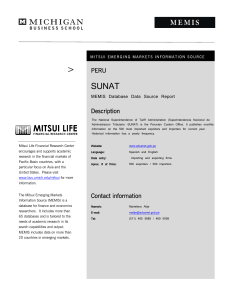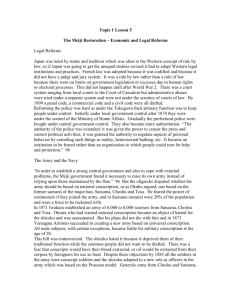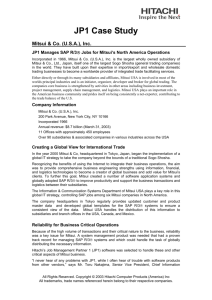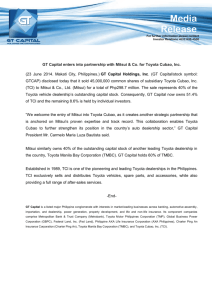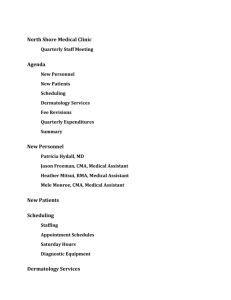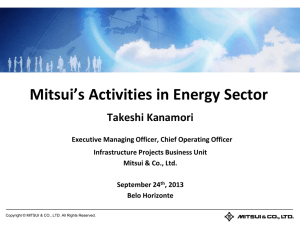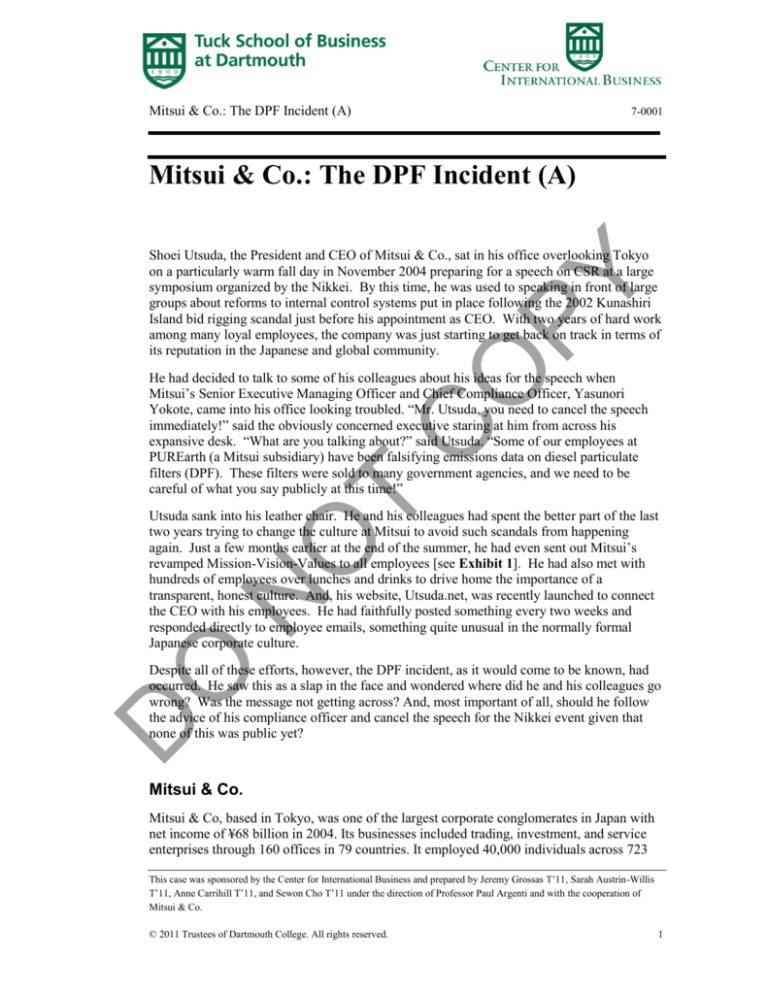
Mitsui & Co.: The DPF Incident (A)
7-0001
Mitsui & Co.: The DPF Incident (A)
O
PY
Shoei Utsuda, the President and CEO of Mitsui & Co., sat in his office overlooking Tokyo
on a particularly warm fall day in November 2004 preparing for a speech on CSR at a large
symposium organized by the Nikkei. By this time, he was used to speaking in front of large
groups about reforms to internal control systems put in place following the 2002 Kunashiri
Island bid rigging scandal just before his appointment as CEO. With two years of hard work
among many loyal employees, the company was just starting to get back on track in terms of
its reputation in the Japanese and global community.
T
C
He had decided to talk to some of his colleagues about his ideas for the speech when
Mitsui’s Senior Executive Managing Officer and Chief Compliance Officer, Yasunori
Yokote, came into his office looking troubled. “Mr. Utsuda, you need to cancel the speech
immediately!” said the obviously concerned executive staring at him from across his
expansive desk. “What are you talking about?” said Utsuda. “Some of our employees at
PUREarth (a Mitsui subsidiary) have been falsifying emissions data on diesel particulate
filters (DPF). These filters were sold to many government agencies, and we need to be
careful of what you say publicly at this time!”
O
N
O
Utsuda sank into his leather chair. He and his colleagues had spent the better part of the last
two years trying to change the culture at Mitsui to avoid such scandals from happening
again. Just a few months earlier at the end of the summer, he had even sent out Mitsui’s
revamped Mission-Vision-Values to all employees [see Exhibit 1]. He had also met with
hundreds of employees over lunches and drinks to drive home the importance of a
transparent, honest culture. And, his website, Utsuda.net, was recently launched to connect
the CEO with his employees. He had faithfully posted something every two weeks and
responded directly to employee emails, something quite unusual in the normally formal
Japanese corporate culture.
D
Despite all of these efforts, however, the DPF incident, as it would come to be known, had
occurred. He saw this as a slap in the face and wondered where did he and his colleagues go
wrong? Was the message not getting across? And, most important of all, should he follow
the advice of his compliance officer and cancel the speech for the Nikkei event given that
none of this was public yet?
Mitsui & Co.
Mitsui & Co, based in Tokyo, was one of the largest corporate conglomerates in Japan with
net income of ¥68 billion in 2004. Its businesses included trading, investment, and service
enterprises through 160 offices in 79 countries. It employed 40,000 individuals across 723
This case was sponsored by the Center for International Business and prepared by Jeremy Grossas T’11, Sarah Austrin-Willis
T’11, Anne Carrihill T’11, and Sewon Cho T’11 under the direction of Professor Paul Argenti and with the cooperation of
Mitsui & Co.
© 2011 Trustees of Dartmouth College. All rights reserved.
1
Mitsui & Co.: The DPF Incident (A)
7-0001
subsidiaries and associated companies. Its mission clearly described the global nature of the
company: “transcending borders to provide necessary goods and services.”
PY
In 1876, the first Mitsui & Co. organization was established with the vision to “Avoid
infatuation with immediate advantage. For enduring prosperity, harbor grand aspirations.”
Soon after its founding, Mitsui dispatched employees across Asia and the world. The
company began to focus on trade and the transfer of information and successfully moved
into the role of an industry organizer. By the beginning of the 20th century, Mitsui was
responsible for 25% of Japanese trade. But by the end of World War II, Mitsui was dissolved
into 223 companies by order of the occupying allied forces.
C
O
One of these 223 companies was Daiichi Bussan, which participated in the post-war growth
and expansion throughout the 1950s and established itself as a major player with raw
material resources as its main focus. It integrated with other trading companies and changed
its name back to Mitsui & Co., Ltd. in 1959. Throughout the 1960s and 1970s, Mitsui grew
alongside Japanese trade and moved into securing resources needed for the country’s growth
and integrating its supply chain locally. In the 1980s, the company expanded into energy,
machinery, electronics and communications. In the decades that followed, it sought to
leverage its “real integrative strength.”
T
As a result of historical growth, by 2004, Mitsui’s business activities spanned across iron
and steel products, energy and mineral resources, oil and gas, infrastructure, motor vehicles,
chemicals, foods, consumer goods and IT. International activities remained a hallmark of
Mitsui’s businesses.
O
Mitsui operated in five business areas:
Petroleum and natural gas
Information technology, electronics, and power plants
N
Minerals and metals
Consumer services (including food and textiles)
O
Chemical production
D
Management was matrix-oriented. As such, the firm was split into three regions – the
Americas, EMEA and Asia-Pacific – which were managed independently. Thirteen
“headquarters business units” served as cross-regional, vertically integrated functions for
business management [see Exhibit 2].
In 2004, Mitsui had annual revenues of ¥2.9 trillion [see Exhibit 3]. Mitsui’s equity shares
were traded on the Tokyo Stock Exchange (where it was included in the Nikkei 225 and
Topix indices) and on the Osaka, Nagoya, Sapporo and Fukuoka exchanges. It had ADRs
listed on the NASDAQ in the United States, where it had a $27.3 billion market
capitalization. Over 130,000 shareholders owned 1.8 billion equity shares. (Mitsui ADRs
were delisted from NASDAQ on April 25th, 2011).
This case was sponsored by the Center for International Business and prepared by Jeremy Grossas T’11, Sarah Austrin-Willis
T’11, Anne Carrihill T’11, and Sewon Cho T’11 under the direction of Professor Paul Argenti and with the cooperation of
Mitsui & Co.
© 2011 Trustees of Dartmouth College. All rights reserved.
2
Mitsui & Co.: The DPF Incident (A)
7-0001
Sogo Shosha
PY
In the early years of the 21st century Mitsui & Co., Ltd. was one of Japan’s eight sogo
shosha1. These trading companies had originated in the mid-twentieth century to facilitate
imports and exports. They later expanded their scope, first establishing their own operations
within specific industries, such as metals or textiles, then branching out to a wide variety of
manufacturing, commercial, and service activities. By the 1960s, the trading companies were
actively engaged in foreign direct investment, establishing numerous overseas offices and
hundreds of foreign affiliates between 1960 and 1980 alone.
C
O
The trading companies were economic powerhouses in their own right. But they also played
an important role in the growth of smaller businesses. Small- and medium-sized enterprises
(SMEs) in Japan relied on trading companies to connect them with markets overseas.
Trading companies were instrumental in the integration of Japanese SMEs with the global
supply chains of much larger foreign firms.
O
T
The last two decades of the twentieth century saw a further shift in the trading companies’
portfolios. Services became an increasingly important part of their business mix, and
manufacturing less significant. They provided a variety of business support services, which
facilitated commerce between Japanese and foreign firms, including logistics, distribution,
back-office outsourcing, and even liquidity and early-stage investment. As analysts at UBS
Warburg saw it, trading companies had evolved far beyond their origins to become major
players in many facets of the economy:
N
Trading companies are involved in just about every business in some fashion or
another, bringing along some domestic or international expertise, although the
function of simply buying something in one country to sell it in another has become
a relatively small part of their business.i
D
O
Japanese trading companies began the new century in a period of recovery, following the
Asian financial crisis. In 2001 they were emerging from a period of restructuring and
divestiture of less-profitable assets. Mitsui had survived the crisis better than most of its
competitors. Its balance sheet was strong, its management was conservative and highlyregarded, and analysts viewed Mitsui as a “safe and sound” investment.ii
However, even Mitsui was not completely unscathed. Some of its business segments,
particularly chemicals, were struggling.iii The company and its management faced pressure
from the investor community to bolster these segments and find new ways to grow revenue.
Analysts at UBS Warburg saw Mitsui’s conservative culture as a challenge to overcome;
1
The others, in approximate order of size were Mitsubishi Corporation, Sumitomo Corporation,
Marubeni Corporation, Nichimen, Nissho Iwai, Itochu Corporation, and Tomen Corporation. A ninth
sogo shosha, Kanematsu, had changed its form to senmon shosha, or a specialized trading company, in
1999 (UNCTAD, 2005). Nichimen and Nissho Iwai merged in April 2003.
This case was sponsored by the Center for International Business and prepared by Jeremy Grossas T’11, Sarah Austrin-Willis
T’11, Anne Carrihill T’11, and Sewon Cho T’11 under the direction of Professor Paul Argenti and with the cooperation of
Mitsui & Co.
© 2011 Trustees of Dartmouth College. All rights reserved.
3
Mitsui & Co.: The DPF Incident (A)
7-0001
they hoped to see Mitsui “challenging their group companies with international
opportunities” and “creating a sense of crisis within the firm.” With economic growth in its
home economy still dampened, Mitsui needed to find the necessary revenue growth
opportunities internationally. Two potential sources of growth were co-investment with
existing foreign firms and greenfield investments in new ventures. Trading companies like
Mitsui were uniquely positioned to serve as “IPO incubators,”iv investing in early-stage
firms.
O
PY
Mitsui’s 2001 agreement with Clean Diesel Technology, and its subsequent
establishment of the PUREarth business in 2002, were intended in part to support this
growth imperative. These investments also addressed the desire of investors for Mitsui to
branch out into new businesses and international ventures, and to loosen the tight control by
the corporate divisions.
Macroeconomic context
C
As one of Japan’s largest trading companies, Mitsui was at the forefront of Japan’s foreign
trade dominated and export-led economy. After World War II, Japan became highly
industrialized, known for its efficient operations, and highly competitive in international
trade. As such, it had strong ties with many nations and organizations.
O
T
Japan’s economy had two tiers: large multinational companies and small, family owned
operations. Manufacturing had been the focus of economic activity and represented 20% of
GDP and the labor force. Japan’s manufacturing base was diversified, ranging from heavy
industry to high technology. Japanese companies began moving to higher value-added
activities after facing competition from low-cost Chinese competitors.v
O
N
From a labor standpoint, Japan faced an aging population. Its population of 127 million
people was projected to decline at an accelerating pace in the coming years. Since its peak in
1995, the working age population had fallen sharply. Meanwhile, the elderly population
increased from 7% to 20% of the total population in only 35 years (versus a projected 86
years in the US and 156 years in France). These challenges aside, Japan’s population was
well-educated and highly literate.
D
Natural resources in Japan were limited. Only 30% of the land was inhabitable, which
not only constricted resource availability but drove up the price and competition for land.
Despite a highly developed train network, other transportation resources were regulated and
oftentimes congested. From an energy standpoint, Japan was the world’s fourth largest
consumer. It depended on imported energy for most of its requirements, although past oil
shocks encouraged efforts in energy efficiency. Oil accounted for 40% of the total primary
energy supply.
Changes in Japanese Corporate Culture
This case was sponsored by the Center for International Business and prepared by Jeremy Grossas T’11, Sarah Austrin-Willis
T’11, Anne Carrihill T’11, and Sewon Cho T’11 under the direction of Professor Paul Argenti and with the cooperation of
Mitsui & Co.
© 2011 Trustees of Dartmouth College. All rights reserved.
4
Mitsui & Co.: The DPF Incident (A)
7-0001
Facing a deep recession in the 1990s, many Japanese companies restructured, laying off
workers and changing promotion and compensation schemes. These restructurings were a
significant shift from the corporate culture based on lifetime employment and senioritybased compensation which were developed during the post-war era and had allowed
Japanese companies to flourish domestically and globally.
PY
The concept of lifetime employment as traditionally found in Japanese companies could be
described as follows:
Workers become employed right after their graduation from school with a particular
company. The employer will not layoff his workers if possible even in the course of
depression. The employee in turn will not quit his job at this company and will
continue working there until he reaches his retirement age.vi
C
O
Although not guaranteed by a written agreement or contract, the lifetime employment system
was more than a gentlemen’s agreement. Some academics even dubbed the system a
“kintract,” the combination of kinship and contract, rooted in Japan’s feudal history.vii The
employee’s bond with the company was so strong that it became a part of one’s identity, and
company loyalty was one of the highest virtues that modern “Samurais” should pursue.
O
T
However, the situation began to change once the economy entered a long recession in the
mid-1990s. As companies went through restructuring, they introduced various systems to
increase labor flexibility. According to a survey conducted by the Labor Ministry in 1996,
about one-third of Japanese companies were trying to cut employment.viii Average new
employment by the largest 1% of firms dropped from 23,000 in 1993 to only 17,400 in
2002.ix Japanese firms began to depend more on contract and temporary employees (haken)
dispatched by staffing agencies.x
O
N
Companies also experimented with applying American-type HR systems of merit-based
payment instead of lifetime employment and seniority-based payment (see Exhibit 4).
According to a survey at the time by RIETI (Research Institute of Economy, Trade &
Industry), an incorporated administrative agency, 36% of firms implemented an employment
adjustment policy over the period of 2000-2003, reducing 15% of the workforce on average,
as by 2004.xi
D
These driving forces affected all sectors, including trading companies:
In the late 1990s, the most important priorities for trading companies were to
reduce costs and secure profits. …Trading companies sought to streamline and
flatten their organizations and minimize costs by reducing the number of executives
and middle-management positions. They adopted profit-focused policies and
enforced their emphasis on results through evaluation systems that focused on shortterm, quantitative outcomes.xii
Mitsui for example, while maintaining lifetime employment, switched from an age-based
remuneration scheme to a results-based scheme in 1999, affecting remuneration from 2000
onwards. Likewise, in 1999 the company changed the salary calculation system based on
This case was sponsored by the Center for International Business and prepared by Jeremy Grossas T’11, Sarah Austrin-Willis
T’11, Anne Carrihill T’11, and Sewon Cho T’11 under the direction of Professor Paul Argenti and with the cooperation of
Mitsui & Co.
© 2011 Trustees of Dartmouth College. All rights reserved.
5
Mitsui & Co.: The DPF Incident (A)
7-0001
qualifications it had developed in the 1970s to put more emphasis on the ability to attain
quantified targets.
PY
The change in the remuneration system resulted in a marked tendency to focus on
work that could easily be reflected in numbers, and in the undervaluation of other
contributions that could be expected to provide long-term benefits but were difficult
to quantify numerically, such as the development of positive and trusting
relationships with customers, the improvement of business environments, and the
training of subordinates.xiii
O
With the gradual erosion of traditional management principles, the working environment
within many Japanese companies and employees’ sense of duty and commitment began to
change. In a survey by the Labor Ministry in 1987, only 42.3% of employees answered that
they would switch to a more satisfying job rather than keep a frustrating one. By 1995, the
number of employees willing to move to more satisfying jobs rose to 63.4%.xiv It became
more acceptable in Japanese society to change companies in pursuit of advancement and job
satisfaction.
O
T
C
A new generation of workers in Japan had started to separate personal goals from those of
their companies. The rise of the NEET (Not in Education, Employment, or Training)
phenomenon marked a stark contrast with the previous generation’s work ethic. An
estimated 400,000 people between the ages of 15 and 24 were in the category of NEET in
2003, five times the figure in 1997.xv These NEET groups were different from traditional
unemployed, as they gave up or chose not to work. In an interview with the BBC, a NEET
young man said, “I realized that life is very short, so I don't have any time. Life is only for
joy....I like losers like me.”xvi
N
Corporate scandals and whistleblowers
O
Over time, changes in Japanese corporate culture and remuneration schemes during the “lost
decade”xvii eroded the social contract and led Japanese employees to feel fewer
obligations towards their companies. Japanese employees became more inclined to speak
out and denounce any wrongdoing, either to defend public interest or to protect themselves
from possible prosecution.xviii
D
This increase in employee whistleblowing contributed to the revelation of a series of
corporate scandals in the late 1990s and early 2000s, which rocked the Japanese corporate
establishment
Mitsubishi
In July 2000, Mitsubishi Motors Corp, the fourth largest Japanese automobile and truck
manufacturer at the time, admitted to covering close to 30 quality defects in its vehicles
following an anonymous telephone tip by a company insider. It was discovered that
Mitsubishi had systematically withheld critical data on various product defects going back as
far as the 1970s. These defects ranged from failing brakes and fuel leaks to malfunctioning
This case was sponsored by the Center for International Business and prepared by Jeremy Grossas T’11, Sarah Austrin-Willis
T’11, Anne Carrihill T’11, and Sewon Cho T’11 under the direction of Professor Paul Argenti and with the cooperation of
Mitsui & Co.
© 2011 Trustees of Dartmouth College. All rights reserved.
6
Mitsui & Co.: The DPF Incident (A)
7-0001
clutches, engine fires and loose axles which caused several fatal accidents. Katsuhiko
Kawasoe, president of Mitsubishi at the time, was forced to step down as a result.
PY
In 2002, a Japanese woman, Shiho Okamoto, was killed in an accident involving a
Mitsubishi Fuso truck’s wheel crashing into her vehicle. In the ensuing investigation,
Mitsubishi claimed that poor maintenance by the truck operator was to blame. However, as
momentum and media coverage picked up around this incident, a manufacturing process
defect was discovered to cause the hubs to break off and wheels to fall off the axles. Some
50 such accidents involving Mitsubishi Fuso trucks (spun off in 2003 to Daimler- Chrysler)
had been classified by the company as being the result of improper use and maintenance by
users.
O
These revelations led to a criminal investigation in the spring of 2004, a raiding of
Mitsubishi’s corporate headquarters, and ultimately the arrest of 7 former executives
including former president Katsuhiko Kawasoe and ex-vice president Takashi Usami on
charges of negligence and falsifying documents.xixxx In total, close to one million cars and
trucks were recalled by Mitsubishi Motors and Mitsubishi Fuso.
N
Snow Brand
O
T
C
The Mitsubishi scandal, considered one of the largest corporate scandals in Japanese history,
stirred public opinion and politicians. Japan’s Transport Minister at the time, Nobuteru
Ishihara accused the company of being “extremely evil” and having “malicious intent.”xxi
Over 40 prefectures and local governments banned the purchase of Mitsubishi vehicles
and the Japanese media increased their scrutiny of incidents involving Mitsubishi cars
and trucks. “National regulators, stung by criticism that the discovery of the company's
second cover-up in four years came only after an investigation by a local police force, are
now randomly stopping Mitsubishi trucks and buses for inspections and demanding weekly
updates from the automakers on internal reviews.”xxii
O
Snow Brand Milk Products, a major Japanese food conglomerate, was also struck by a series
of scandals in 2000-2002, which shocked public opinion. Until then, the public had placed a
high level of trust in the food supply chain. The incidents at Snow Brand marked the
beginning of intensified public scrutiny of food suppliers which ultimately led to unveiling
inappropriate actions at other mainstream food companies.
D
Snow Brand’s first scandal was a food-poisoning incident in the summer of 2000 during
which 14,800 people in Western Japan became sick after consuming milk and milk-based
products that had been contaminated by bacteria.xxiii The source of the bacteria was traced
back to a valve which had not been regularly cleaned and maintained. The company initially
attempted to cover information about the full extent of the incident, alleging that the valve
was rarely used although it was in fact used daily.xxiv Company President Tetsuro Ishikawa
and seven executives resigned to take responsibility for mismanaging the situation.xxv
In February 2002, Snow Brand was hit by another scandal. The company admitted to
relabeling 13.8 tonsxxvi of Australian beef to pass it off as Japanese and receive government
subsidies aimed at helping domestic Japanese meat production affected by an outbreak of
This case was sponsored by the Center for International Business and prepared by Jeremy Grossas T’11, Sarah Austrin-Willis
T’11, Anne Carrihill T’11, and Sewon Cho T’11 under the direction of Professor Paul Argenti and with the cooperation of
Mitsui & Co.
© 2011 Trustees of Dartmouth College. All rights reserved.
7
Mitsui & Co.: The DPF Incident (A)
7-0001
mad cow disease in Japan. Shortly after, the company admitted to extending the expiration
date on 760 tons of frozen butter that had aged beyond the 18-month limit.
Whistleblowing
PY
In 2002, Time Magazine’s People of the Year included three individuals who revealed their
own organizations’ misconduct - Cynthia Cooper of WorldCom, Sherron Watkins of Enron,
and Coleen Rowley of the FBI who exposed the agency's slow action prior to the
September 11 attacks. When Time globally recognized these three whistleblowers,
Japanese society was also experiencing significant changes in its attitude toward
whistleblowing. Until the early 1990s, when Japanese firms were able to provide
lifetime employment and enjoy strong loyalty from the employees, whistleblowing was
almost non- existent in Japan.
O
T
C
O
Alongside the economic and psychological changes that led to the deterioration of employee
commitment to the companies, scandals raised public awareness about the need for a system
to detect and expose bureaucratic or corporate malfeasance. Etsuko Kawada, a nonpartisan
Diet member whose hemophiliac son contracted HIV from a tainted blood transfusion
along with hundreds of others, fought against the Ministry of Health, Labor and Welfare and
drug companies who were well aware that the blood was contaminated but hid the fact to
protect the domestic pharmaceutical industry. In 2002, she drafted legislation for the Public
Interest Disclosure Law to provide a safer environment for the whistleblowers, “a line of
defense against corporate and bureaucratic malfeasance”.xxvii
The Kunashiri Incident
D
O
N
Mitsui had also been affected by the rise in scandals in Japan. On July 3, 2002, three Mitsui
employees were arrested by the Special Investigation Branch of the Tokyo District Public
Prosecutor’s Office, which had been investigating the suspicions of Diet member Muneo
Suzuki. One of these employees was the head of the industrial project team. According to the
investigation, the employees tried to rig the bidding process to win the diesel power plant
project on the Russian-held island of Kunashiri off of Hokkaido. To win the project, Mitsui
employees illegally gained information on the scheduled price from the officer in charge at
the Ministry of Foreign Affairs and also persuaded rival companies to withdraw from
participation in the bidding. As a result, Mitsui had made a successful bid of ¥1,992,270,000,
which amounted to 99.9% of the ministry’s scheduled price. They also blocked rival trading
companies from participating in the bidding, and instead brought in two other companies
that had no interest in the business.xxviii
A few weeks later, when two of the arrested employees were indicted, chairman of the board
Shigeji Ueshima and the president and CEO Shinjiro Shimizu offered to take 20 percent pay
cuts for three months to accept responsibility for the crimes committed.
However, matters worsened when in August it was reported that one of the arrested
employees was under investigation by the Prosecutor’s Office for suspicions of bribing
This case was sponsored by the Center for International Business and prepared by Jeremy Grossas T’11, Sarah Austrin-Willis
T’11, Anne Carrihill T’11, and Sewon Cho T’11 under the direction of Professor Paul Argenti and with the cooperation of
Mitsui & Co.
© 2011 Trustees of Dartmouth College. All rights reserved.
8
Mitsui & Co.: The DPF Incident (A)
7-0001
government officials in Mongolia to win a power plant contract. In September 2002,
Mitsui’s chairman, Shigeji Ueshima, who was then a vice chairman of the Nippon
Keidanren, and president, Shinjiro Shimizu, resigned to take responsibility under pressure
from an outraged public and the Japanese media.
O
PY
Mitsui’s handling of the crisis was sharply criticized. The company faced severe criticism
from society, particularly because the incident was connected with government funds. Public
disclosure had come late after the company spent time verifying information and debating
internally about how the disclosure should be made. Each decision was conducted according
to traditional Japanese management practices, with consensus-building carried out across
various departments including Corporate Communications, Corporate Planning and Strategy,
and Legal. As a result, reaction time was slow and information given to the media was
minimal and strictly controlled. Overall, this gave the impression the company was still
trying to hide information, further exacerbating media scrutiny of the incident. xxix
T
C
Critiques also pointed out that the root causes lay in Mitsui’s fundamental management
approach, not in a few overzealous employees’ aggressive approach. In the late 1990s,
trading companies were focusing on reducing costs and securing profits. Along with such a
shift in focus, the companies introduced the principle of competition and differentiating
salaries to take the best value out of each employee. Evaluation was based mainly on
quantitative values, such as year-on-year sales growth or progress toward targets. However,
as there was no recognition for contributions that could not be measured numerically, the
system led to a decline in employee morality.xxx
N
O
Along with the resignation of the Chairman and CEO, the Kunashiri incident led to a
management reshuffle in October 2002. Shoei Utsuda, who had previously been a senior
executive managing officer, was appointed President and CEO.
Shoei Utsuda
O
Shoei Utsuda was born in 1943 and graduated from University of Tokyo in 1967 with a
Bachelor of Science. He joined Mitsui upon graduation and was shortly thereafter sent to the
United States to study at Dartmouth College as a special student for the 1969-1970 academic
year.
D
From 2000 to 2002, Utsuda was in charge of reorganizing Mitsui’s vast holdings into five
business areas:
Petroleum and natural gas
Information technology, electronics, and power plants
Chemical production
Minerals and metals
This case was sponsored by the Center for International Business and prepared by Jeremy Grossas T’11, Sarah Austrin-Willis
T’11, Anne Carrihill T’11, and Sewon Cho T’11 under the direction of Professor Paul Argenti and with the cooperation of
Mitsui & Co.
© 2011 Trustees of Dartmouth College. All rights reserved.
9
Mitsui & Co.: The DPF Incident (A)
7-0001
Consumer services (including food and textiles)
In April 2002 Utsuda's reorganization reached the top of Mitsui when he reduced the size of
the company's board of directors from 38 to 11.
PY
Shortly after Mitsui’s Chairman and CEO resigned following the Kunashiri Island bidrigging incident, Utsuda was appointed CEO in October of 2002. “My top priority at that
time was to reform internal controls and corporate compliance.”xxxi The press, however,
pushed for Utsuda to resign since he had been an advisor to former president Shimizu.
Utsuda instead proposed a 20% pay cut for himself and insisted that he had the full support
of the company’s board members and that it was his “destiny” to serve as CEO.xxxii
C
O
On September 16, 2002, Utsuda told a press conference, “There was an absence of a strong
sense of morality and of high ideals” in Mitsui & Co.'s management.xxxiii He quickly
announced his intention to deeply reform the company’s culture. The transformation he
envisioned went beyond the culture and tackled a redefining of the company’s place in the
world. As a result, Utsuda launched an organizational reform program aimed at tackling the
root causes of the Kunashiri incident focused on changing the mindset of employees and
establishing a management platform centered on internal controls and compliance.
N
O
T
To keep Mitsui’s employees motivated and on board with the transformation the company
was about to create, he issued a message to all employees stating that Mitsui would aspire to
go back to the goal of “Challenge and Innovation.” He further requested that employees be
fully compliant with the law, regulations and company’s rules and asked for everyone’s
efforts to help restore the company’s reputation. Utsuda also went back to the words of
Mitsui’s founder, Takashi Masuda, who recommended to his employees to “avoid
infatuation with immediate advantage.”xxxiv The company had been around since 1879 and
had survived since thanks to these basic principles. It was now, more than ever, time to
return to those values. As Masuda had stated: “above all else, in business, being trusted is
paramount.”xxxv
O
Finally, Utsuda listed four values as criteria for decisions and actions by Mitsui’s employees
in his statement:
We always stand alongside our customers.
We recognize that trust is the foundation for all of our business activities.
We use our integrated strengths to create value through the fusion of goods, services
and businesses.
We aim to evolve in the world as a global enterprise with origins in Japan.xxxvi
D
In addition to the ethical issues affecting the company, the business model of sogo shosha
was changing and Utsuda wanted to make sure that Mitsui could transform itself into a
dynamic value-creating organization. In April 2003, Utsuda rolled out his strategy for
This case was sponsored by the Center for International Business and prepared by Jeremy Grossas T’11, Sarah Austrin-Willis
T’11, Anne Carrihill T’11, and Sewon Cho T’11 under the direction of Professor Paul Argenti and with the cooperation of
Mitsui & Co.
© 2011 Trustees of Dartmouth College. All rights reserved.
10
Mitsui & Co.: The DPF Incident (A)
7-0001
Business Process Re-engineering (BPR) and declared a new vision for Mitsui as a “global
business enabler” with a strong focus on how Mitsui’s employees were the core drivers of
value for the company.
PY
To give weight to his ideas and ensure that all employees were on board, Utsuda arranged
for the republishing and redistribution of Mitsui’s history, “Chosen to sozo” (Challenge and
Innovation), initially published in 1976. He also instituted small group meetings with
employees once or twice a month to discuss face-to-face the company’s goals, BPR, and
other issues, with the aim of making himself more accessible. Utsuda communicated directly
with employees through initiatives such as the periodic “CEO Column” or “Utsuda.net”
where employees could send questions directly to the CEO.
O
In August 2004, Utsuda again addressed Mitsui’s employees and announced a new
management philosophy (Mission-Vision-Values) [see Exhibit 1], the establishment of basic
CSR Policy, the creation of a CSR Promotion Committee, and an Advisory Committee to
Board of Directors. In this message, he again looked to Mitsui’s roots to instill the values
core to the company’s founding principles in all employees.xxxvii
N
O
T
C
Utsuda also wanted these principles to be fully understood by his employees or they would
“just amount to painting pictures on the sand”xxxviii. He created Utsuda.net, a website which
would allow him to connect directly with employees through blog-type postings in which he
described his daily activities, meetings and thoughts about the company. He also enabled
employee emails to be sent directly to him and would thus engage in one-on-one discussions
with employees, thus making it easier for employees to speak up and voice their concerns.
Another attempt to create an open culture were the frequent round-table lunches or “after 5
p.m.” drinking parties in order to trigger a dialogue with employees of different levels across
the company. These efforts went beyond the traditional human resource development
seminars during which employees were trained on the company’s mission-vision-values.
PUREarth and Diesel Particulate Filters (DPF)
D
O
DPF, or diesel particulate filter, was a device designed to remove diesel particulate matter or
soot from the exhaust gas of a diesel engine, by simply being attached to exhaust pipes and
mufflers [see Exhibit 5]. In 1999, the Tokyo Metropolitan Government, under
newly-elected Governor Shintaro Ishihara, announced “Operation No Diesel,” and
restrictions on diesel vehicles running in Tokyo and the three adjacent prefectures
(Kanagawa, Saitama, and Chiba) to be effective from October 2003.
To satisfy these new emissions standards, haulage companies had to either purchase new
vehicles or install purifying units such as DPF. However, the price of DPFs was a deterrent,
selling for ¥1 million. To relieve the financial burden to the companies, the Tokyo
government provided up to ¥400,000 in subsidies for the commercial purchase of DPFs. To
be eligible for the government subsidy, the DPF product had to be designated as a Certified
Particulate Matter Reduction System beforehand.
This case was sponsored by the Center for International Business and prepared by Jeremy Grossas T’11, Sarah Austrin-Willis
T’11, Anne Carrihill T’11, and Sewon Cho T’11 under the direction of Professor Paul Argenti and with the cooperation of
Mitsui & Co.
© 2011 Trustees of Dartmouth College. All rights reserved.
11
Mitsui & Co.: The DPF Incident (A)
7-0001
PY
Capturing this new demand, Mitsui entered the DPF market through a partnership with
Clean Diesel Technology (CDT), a specialty chemical company in the United States. The
original agreement with CDT signed in July 2001 granted Mitsui an exclusive license for the
use of CDT's patented technology in Japan. On September 2, 2002, Mitsui invested ¥200
million to set up its PUREarth subsidiary, which was in charge of mass producing the SOW301B filter. While PUREarth manufactured the filter devices in Japan, CDT provided
application engineering and marketing in the U.S., as well as managing the CARB
(California Air Resources Board) and EPA (Environmental Protection Agency) verification
programs.
Data Falsification
C
O
The first false data was submitted on February 18, 2002, when Mitsui applied for
certification. The data was taken from multiple DPFs including those which had different
specifications from the SOW-301B filter. A DPF with a smaller wire diameter mesh filter
was used for the performance test to achieve a higher particulate matter filtration ratio,
whereas another DPF with a larger wire diameter mesh filter was used for the endurance test
to show higher durability. In other words, the DPF that were actually supplied to the
Japanese market turned out not to meet the government regulations.
T
Later in July 2002, Mitsui fabricated data again in the application for the exterior
modification of its DPF, where the same method of merging data from different products
was used to make the test results exceed government requirements.
N
O
In the quality test attended by Tokyo government officials in January 2003, it was detected
that the SOW-301B's filtration could capture only about 40% of particulate matter from
engine exhaust, when the government’s requirement was 60% or more. Upon detection,
PUREarth agreed to replace DPFs on 143 metropolitan buses free of charge, but it did not
take action for the same low-performance DPFs on 518 buses run by private operators.
Moreover, to recover the loss from the free replacement, the company resold the DPFs
removed from the 143 buses to bus operators in other prefectures at prices between ¥400,000
and ¥600,000.xxxix
D
O
In the meantime, PUREarth had been extending its partnership with CDT. In January 2003,
the two companies made definitive amendments to their original agreement. While the
original agreement limited PUREarth’s usage right for CDT’s propriety technology over
stationary applications in Japan only, the new amendment included an extension to
cover mobile applications in Japan. By June 2004, PUREarth was taking responsibilities
for design, manufacturing, and marketing of a proprietary filter under the PUREcat™ trade
name, for which CDT applied for EPA verification along with its own catalyst.xl
Throughout Japan, PUREarth had sold 21,500 units of DPFs, which accounted for 30% of
the market share or ¥20 billion in sales, making it the market leader.xli With such a high
market share, the total subsidies provided to PUREarth’s customers by four local
governments (Tokyo, Chiba, Saitama and Kanagawa) were reported to reach around ¥6
billion.xlii
This case was sponsored by the Center for International Business and prepared by Jeremy Grossas T’11, Sarah Austrin-Willis
T’11, Anne Carrihill T’11, and Sewon Cho T’11 under the direction of Professor Paul Argenti and with the cooperation of
Mitsui & Co.
© 2011 Trustees of Dartmouth College. All rights reserved.
12
Mitsui & Co.: The DPF Incident (A)
7-0001
The Revelation
The two-year long fraud was detected in an unexpected way. In the summer 2004, to conduct
Mitsui’s periodic internal audit, Mitsui placed a designated auditor at PUREarth. Soon
afterward, on November 12, a low-level Mitsui employee disclosed his involvement in data
falsification to his supervisor, who then reported it to the department head the following day.
It was on November 16 that Utsuda first received the report.xliii
D
O
N
O
T
C
O
PY
As he looked at the startled face of his colleague, he thought about the potential for all of the
hard work by so many at Mitsui going up in smoke as a result of a new scandal. Was the
speech he was about to give exactly the right forum to release this revelation, or did he need
to think about the timing more carefully. What would happen if someone else released this
information first? And, most importantly, what was the right thing to do in this situation?
This case was sponsored by the Center for International Business and prepared by Jeremy Grossas T’11, Sarah Austrin-Willis
T’11, Anne Carrihill T’11, and Sewon Cho T’11 under the direction of Professor Paul Argenti and with the cooperation of
Mitsui & Co.
© 2011 Trustees of Dartmouth College. All rights reserved.
13
Mitsui & Co.: The DPF Incident (A)
7-0001
Case Questions
D
O
N
O
T
C
O
PY
1. What should Utsuda do immediately?
2. In the longer run, how should he go about to make sure the company’s core
values are understood and internalized by employees? How could he change
the company’s culture in depth?
3. Evaluate the strategy Utsuda put in place for Mitsui.
4. How would you assess Utsuda as a leader?
This case was sponsored by the Center for International Business and prepared by Jeremy Grossas T’11, Sarah Austrin-Willis
T’11, Anne Carrihill T’11, and Sewon Cho T’11 under the direction of Professor Paul Argenti and with the cooperation of
Mitsui & Co.
© 2011 Trustees of Dartmouth College. All rights reserved.
14
Mitsui & Co.: The DPF Incident (A)
7-0001
Exhibit 1: Corporate Mission-Vision-Values
Mission: Strive to contribute to the creation of a future where the aspirations
of the people can be fulfilled.
Values: Build trust with fairness and humility.
PY
Vision: Aim to become a global business enabler that can meet the needs of our
customers throughout the world
D
O
N
O
T
C
O
Aspire to set high standards and to contribute to society.
Embrace the challenge of continuous innovation.
Foster a culture of open-mindedness.
Strive to develop others and oneself to achieve full potential.
This case was sponsored by the Center for International Business and prepared by Jeremy Grossas T’11, Sarah Austrin-Willis
T’11, Anne Carrihill T’11, and Sewon Cho T’11 under the direction of Professor Paul Argenti and with the cooperation of
Mitsui & Co.
© 2011 Trustees of Dartmouth College. All rights reserved.
15
Mitsui & Co.: The DPF Incident (A)
7-0001
D
O
N
O
T
C
O
PY
Exhibit 2: Mitsui Organizational Structure
This case was sponsored by the Center for International Business and prepared by Jeremy Grossas T’11, Sarah Austrin-Willis
T’11, Anne Carrihill T’11, and Sewon Cho T’11 under the direction of Professor Paul Argenti and with the cooperation of
Mitsui & Co.
© 2011 Trustees of Dartmouth College. All rights reserved.
16
Mitsui & Co.: The DPF Incident (A)
7-0001
Exhibit 3: Mitsui & Co. Financials 2004 (Year ending March 31, 2004)
2,970
611
129
40
79
68
(34)
O
For the Year:
Revenues
Gross Profit
Operating Income
Equity in Earnings of Associated Companies
Income from Continuing Operations
Net Income
Free Cash Flows
PY
Billions of JPY
2004
2003
2002
6,716
963
638
2,541
7.5%
2,475
537
81
24
61
55
51
6,541
862
695
2,500
3.5%
6,668
915
634
2,619
6.3%
D
O
N
O
T
C
At Year-End:
Total Assets
Total Shareholders' Equity
Cash and Cash Equivalents
Long-term Debt, less Current Maturities
Return on Equity (ROE)
2,778
566
102
15
39
31
48
Source: Company Annual Report
This case was sponsored by the Center for International Business and prepared by Jeremy Grossas T’11, Sarah Austrin-Willis
T’11, Anne Carrihill T’11, and Sewon Cho T’11 under the direction of Professor Paul Argenti and with the cooperation of
Mitsui & Co.
© 2011 Trustees of Dartmouth College. All rights reserved.
17
Mitsui & Co.: The DPF Incident (A)
7-0001
C
O
PY
Exhibit 4: American-type (A-type) vs. Japanese-type (J-type) Employment
System, 2003
D
O
N
O
T
Gregory Jackson, “The Changing Role of Employees in Japanese Corporate Governance:
Participation, Adjustment and Distributional Conflict”, REITI Symposium, October 20, 2004
This case was sponsored by the Center for International Business and prepared by Jeremy Grossas T’11, Sarah Austrin-Willis
T’11, Anne Carrihill T’11, and Sewon Cho T’11 under the direction of Professor Paul Argenti and with the cooperation of
Mitsui & Co.
© 2011 Trustees of Dartmouth College. All rights reserved.
18
Mitsui & Co.: The DPF Incident (A)
7-0001
D
O
N
O
T
C
O
PY
Exhibit 5: Diesel Particulate Filter (DPF)
This case was sponsored by the Center for International Business and prepared by Jeremy Grossas T’11, Sarah Austrin-Willis
T’11, Anne Carrihill T’11, and Sewon Cho T’11 under the direction of Professor Paul Argenti and with the cooperation of
Mitsui & Co.
© 2011 Trustees of Dartmouth College. All rights reserved.
19
Mitsui & Co.: The DPF Incident (A)
7-0001
Endnotes
i
O
T
C
O
PY
Williams, T. and Ishida, N. “A New Look – Japan’s Trading Companies.” UBS Warburg, July 25,
2000.
ii
Williams and Ishida (2000).
iii Soejima, T. “Japan Trading Companies: 1H Results Good Overall; Core Earnings Power is Up.”
Morgan Stanley Dean Witter Equity Research, November 17, 2000.
iv Williams and Ishida (2000).
v Economist Intelligence Unit. “Japan: Country Profile.” 2008.
vi Kazuo Koike, "Nihonteki Koyo Kanko" ["Japanese Employment Practices"] in Toyokeizai
Shinposha, ed., Keizaigaku Daijiten [Encyclopedia of Economics] (Tokyo, Toyokeizai Shimpo Sha,
1980), Vol. II, pp.100-OS.
vii Yamaguchi Kazuo, The State and Change in the "Lifetime Employment" in Japan: From the End
of War Through 1995, RIETI, November 2004.
viii Sheryl WuDunn, “Lifetime Employment Is No Longer a Given at Japanese Companies,” New
York Times, June 12, 1996.
ix Gregory Jackson, “The Changing Role of Employees in Japanese Corporate Governance:
Participation, Adjustment and Distributional Conflict”, REITI Symposium, October 20, 2004.
x Yamaguchi Kazuo, RIETI, November 2004.
xi Gregory Jackson, REITI Symposium, October 20, 2004.
xii Ikujiro Nonaka, “Nagare wo keiei suru”(“Managing Flow”), Chapter 6.
xiii “Nagare wo keiei suru”, Chapter 6, Ikujiro Nonaka.
xiv Sheryl WuDunn, New York Times, June 12, 1996.
O
N
xv Akemi Nakamura, “Being NEET not so neat for nation's youth”, The Japan Times, June 19, 2004.
xvi Sarah Buckley, “Japan’s free spirits”, BBC News, September 30, 2004.
xvii Lost decade: term used to describe the economic recession of the 1990s.
xviii “In Shift for Japan, Salarymen Blow the Whistle”, Martin Fackler, The New York Times, June 7,
2008.
xix “Former Mitsubishi bosses arrested”, BBC News, May 6, 2004.
xx “Safety Scandal Shames Mitsubishi”, Anthony Faiola, The Washington Post, July 6, 2004.
xxi “Japanese police arrest seven former Mitsubishi executives” Reuters, December 5, 2004.
D
xxii “Safety Scandal Shames Mitsubishi”, Anthony Faiola, The Washington Post, July 6, 2004.
xxiii http://brandfailures.blogspot.com/2006/12/brand-pr-failures-snow-brand-milk.html.
xxiv “Snow lied after milk poisoning case”, Japan Times, July 5, 2000.
xxv http://www.mallenbaker.net/csr/crisis04.html.
xxvi “Snow to halt beef sales”, Japan Times, January 26, 2002.
xxvii Hiroko Tashiro, “Breaking Japan’s conspiracy of silence”, Time, July 22, 2002.
xxviii Mitsui & Co., LTD. “The Spirit of Mitsui & Co.- Our Legacy in Our Own Words,” p128, 2007.
xxix Interview of Mr. Kimura, Mitsui Corporate Communications, May 10, 2011.
xxx “Nagare wo keiei suru”, Chapter 6, Ikujiro Nonaka.
xxxi Chairman Utsuda, Address to Tuck School of Business Students, October 12, 2010,
http://mba.tuck.dartmouth.edu/cib/Utsuda_October2010.html.
This case was sponsored by the Center for International Business and prepared by Jeremy Grossas T’11, Sarah Austrin-Willis
T’11, Anne Carrihill T’11, and Sewon Cho T’11 under the direction of Professor Paul Argenti and with the cooperation of
Mitsui & Co.
© 2011 Trustees of Dartmouth College. All rights reserved.
20
Mitsui & Co.: The DPF Incident (A)
7-0001
O
PY
xxxii New Mitsui president vows change in company mentality, Asian Economic News, Sept 16,
2002.
xxxiii New Mitsui president vows change in company mentality, Asian Economic News, Sept 16,
2002.
xxxiv “Sogo Shosha’s Challenges and Opportunities”, presentation by Chairman Utsuda at The
Foreign
Correspondent’s Club of Japan, October 30, 2008.
xxxv Mitsui Co. History, Yoshiya Watanabe, Mitsui & Co. HRD Institute.
xxxvi “Nagare wo keiei suru”, Ikujiro Nonaka.
xxxvii “Nagare wo keiei suru”, Ikujiro Nonaka.
xxxviii “Regaining Trust”, Ernst & Young Seminar, Shoei Utsuda, December 16, 2005.
D
O
N
O
T
C
xxxix “Ex-Mitsui officials held over scam,” The Daily Yomiuri, June 15, 2005.
xl “Clean Diesel Technologies Receives EPA Verification for Second Diesel Retrofit System; System
Developed with Mitsui/PUREarth Reduces Soot by Up To 75 Percent,” Business Wire, June 7, 2004.
xli “The Spirit of Mitsui & Co.- Our Legacy in Our Own Words,” p130.
xlii “Tokyo police probe Mitsui & Co over alleged data fabrication,” AFX European Focus,
December 27, 2004.
xliii Interview with Chairman Utsuda, June28, 2011; ”Mitsui admits to diesel filter scam,” The
Nikkei Weekly, November 29, 2004.
This case was sponsored by the Center for International Business and prepared by Jeremy Grossas T’11, Sarah Austrin-Willis
T’11, Anne Carrihill T’11, and Sewon Cho T’11 under the direction of Professor Paul Argenti and with the cooperation of
Mitsui & Co.
© 2011 Trustees of Dartmouth College. All rights reserved.
21

